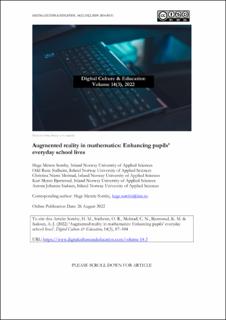| dc.contributor.author | Somby, Hege Merete | |
| dc.contributor.author | Stalheim, Odd Rune | |
| dc.contributor.author | Mølstad, Christina Elde | |
| dc.contributor.author | Bjørnsrud, Kari Myren | |
| dc.contributor.author | Isaksen, Aurora Johanne | |
| dc.date.accessioned | 2022-11-14T09:36:53Z | |
| dc.date.available | 2022-11-14T09:36:53Z | |
| dc.date.created | 2022-08-25T09:47:10Z | |
| dc.date.issued | 2022 | |
| dc.identifier.citation | Digital Culture and Education. 2022, 14 (3), 87-104. | en_US |
| dc.identifier.issn | 1836-8301 | |
| dc.identifier.uri | https://hdl.handle.net/11250/3031608 | |
| dc.description.abstract | This article presents findings from a study focused on using technology as a learning tool in education. Educational research on game-based learning argues that technology-based learning tools effectively enhance learning and memory. Augmented reality (AR) technology is attracting significant attention; its importance will continue to increase as new learning environments are exploited and new possibilities for promoting flexible and playful learning are revealed. This study investigated pupils’ experiences with an AR application by comparing experiences and reflections from pupils who learned mathematics using the Wittario game-based learning application with pupils exposed to more traditional instructional methods. 72 pupils in 5th and 6th grade, divided into three different test groups, and 5 teachers were interviewed. The study revealed that the application provided more subjectoriented interactions, and pupils expressed a high level of motivation and peer affiliation when using the application. Our findings, therefore, reveal that using the application, especially when facilitating tasks that involve peer collaboration and interaction with a specter of features available, contributes to a positive learning environment. Also uncovered was that the teacher’s presence and positioning of the activity in a pedagogical context are essential to this process. | en_US |
| dc.language.iso | eng | en_US |
| dc.relation.uri | https://www.digitalcultureandeducation.com/volume-14-3 | |
| dc.rights | Navngivelse-Ikkekommersiell-DelPåSammeVilkår 4.0 Internasjonal | * |
| dc.rights.uri | http://creativecommons.org/licenses/by-nc-sa/4.0/deed.no | * |
| dc.subject | AR technology | en_US |
| dc.subject | learning | en_US |
| dc.subject | motivation | en_US |
| dc.subject | physical activity/movement | en_US |
| dc.subject | mathematics | en_US |
| dc.subject | gaming | en_US |
| dc.title | Augmented reality in mathematics: Enhancing pupils’ everyday school lives | en_US |
| dc.type | Peer reviewed | en_US |
| dc.type | Journal article | en_US |
| dc.description.version | publishedVersion | en_US |
| dc.subject.nsi | VDP::Samfunnsvitenskap: 200 | en_US |
| dc.source.pagenumber | 87-104 | en_US |
| dc.source.volume | 14 | en_US |
| dc.source.journal | Digital Culture and Education | en_US |
| dc.source.issue | 3 | en_US |
| dc.identifier.cristin | 2045855 | |
| cristin.ispublished | true | |
| cristin.fulltext | original | |
| cristin.qualitycode | 1 | |

